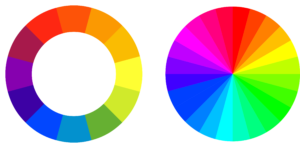In the hierarchy of influence as related to design elements, color comes out on top. Color is the most quickly assessed element and has a potent psychological and physiological effect conveying a tone, emotion, or idea. Think of the color red, for example. Red can evoke feelings of warmth and comfort or feelings of anger and hostility. Orange can evoke feelings of excitement and enthusiasm, draw your attention, instill caution, and even stimulate appetite. Effectively using color theory is key to good design and often crucial to a successful user experience. As a designer, color selection is one of the first elements considered.
Fundamentals of Color Theory
Effective color use requires understanding the fundamentals of color theory. Color theory is the art and science of combining colors and the practical guidance for color mixing. The color wheel is at the heart of color theory as it helps designers find working color combinations to artfully and successfully convey their ideas and create themes. On the wheel, you will see red, yellow, and blue as the primary colors, and orange, green, and purple as the secondary colors. The mixture of primary and secondary creates the tertiary colors. Harmonious, complementary colors result from selecting colors opposite of one another on the wheel. A color’s hue can be changed through the addition of white for tint, resulting in pastels, or black for shade for a darkened color. Adding gray to a primary, secondary, or tertiary color creates tone which also affects brightness and intensity. The possibilities are endless.

Why is Color Theory Important in Design?
Designers use color theory to communicate how a product is used and what to signal to the viewer. A very basic example would be using green to indicate a correct or proper action and red to indicate an incorrect or cautioned action. Warm and cool colors have different psychological effects and can be used to engage or sway a viewer’s mood.

In conclusion, color is a powerful tool. It is considered one of the most important design elements for its ability to engage through evoking emotions, stimulating ideas, influencing perceptions, and inspiring reactions.